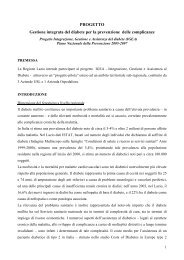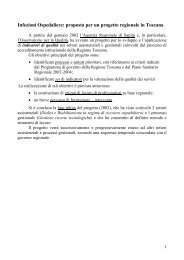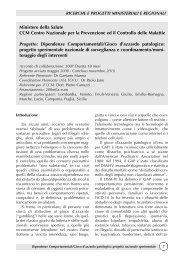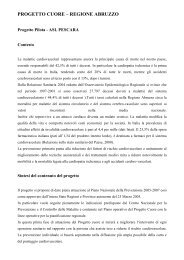Gaining health : analysis of policy development in European ...
Gaining health : analysis of policy development in European ...
Gaining health : analysis of policy development in European ...
You also want an ePaper? Increase the reach of your titles
YUMPU automatically turns print PDFs into web optimized ePapers that Google loves.
Chapter 4<br />
106<br />
2.3.3. Sett<strong>in</strong>g the agenda<br />
Unlike <strong>in</strong> many <strong>European</strong> countries, there is no tradition <strong>in</strong><br />
Greece <strong>of</strong> prepar<strong>in</strong>g public <strong>health</strong> reports. The universities<br />
and large NGOs make fragmented attempts to analyse aspects<br />
<strong>of</strong> the situation, focus<strong>in</strong>g on issues <strong>of</strong> <strong>in</strong>terest to them,<br />
but there is no <strong>of</strong>ficial published report giv<strong>in</strong>g a comprehensive<br />
picture <strong>of</strong> the <strong>health</strong> challenges and their determ<strong>in</strong>ants<br />
and the ways <strong>in</strong> which these might be tackled. By default,<br />
the focus rema<strong>in</strong>s on the organization and reorganization<br />
<strong>of</strong> <strong>health</strong> care, with pass<strong>in</strong>g <strong>in</strong>terest <strong>in</strong> other issues when<br />
these are raised by <strong>in</strong>terested researchers or NGOs, or<br />
when a “world day” on a particular theme is celebrated.<br />
The “Health Map” (18) (see below) is to br<strong>in</strong>g together a<br />
considerable amount <strong>of</strong> data <strong>in</strong> an organized way and could<br />
perhaps shift the future agenda.<br />
Given the lack <strong>of</strong> focus on relevant data concern<strong>in</strong>g <strong>in</strong>equalities<br />
<strong>in</strong> <strong>health</strong> <strong>in</strong> the <strong>policy</strong> proposals available to us, the l<strong>in</strong>k<br />
between socioeconomic <strong>in</strong>equalities <strong>in</strong> <strong>health</strong> and the need<br />
to address the determ<strong>in</strong>ants <strong>of</strong> <strong>health</strong> is almost nonexistent<br />
2.3.4. F<strong>in</strong>d<strong>in</strong>g solutions<br />
S<strong>in</strong>ce the <strong>health</strong> challenges have yet to be openly discussed<br />
outside academic circles, solutions rema<strong>in</strong> focused ma<strong>in</strong>ly<br />
on the provision <strong>of</strong> <strong>health</strong> care or are l<strong>in</strong>ked to the potential<br />
for EU fund<strong>in</strong>g. As observed <strong>in</strong> certa<strong>in</strong> other countries,<br />
attention is paid to high-visibility action such as provid<strong>in</strong>g<br />
<strong>in</strong>tensive care units and reduc<strong>in</strong>g wait<strong>in</strong>g lists rather than<br />
the long-term and less visible action needed to tackle NCD.<br />
Disease prevention relies on <strong>health</strong> education rather than<br />
<strong>health</strong> promotion. Issues related to the use <strong>of</strong> new communications<br />
technology seem to be high on the agenda, aga<strong>in</strong><br />
partly due to the availability <strong>of</strong> EU fund<strong>in</strong>g.<br />
Implementation <strong>of</strong> the 2005 Law on Public Health should<br />
<strong>of</strong>fer hope for change <strong>in</strong> the future, as should the plan <strong>of</strong><br />
action for public <strong>health</strong> currently be<strong>in</strong>g formulated. The<br />
grow<strong>in</strong>g attention given by the EU to tackl<strong>in</strong>g <strong>health</strong> risks<br />
could, <strong>in</strong> the long run, open up the discussion <strong>in</strong> Greece.<br />
2.3.5. Structures and processes for implementation<br />
Article 8 <strong>of</strong> the 2005 Law on Public Health provides that<br />
the MHSS, together with the National Council for Public<br />
Health, will decide on the priorities for public <strong>health</strong> and<br />
formulate four-year action plans, which are to be compulsory<br />
for the regional level <strong>of</strong> government.<br />
2.3.6. Monitor<strong>in</strong>g and evaluation<br />
Provisions are made <strong>in</strong> the 2005 Law on Public Health<br />
for annual reports to Parliament on the <strong>health</strong> status <strong>of</strong><br />
the population. Similar reports are to be prepared at the<br />
regional level. This provision has not yet been implemented<br />
but, if well founded with structures and processes <strong>in</strong> place<br />
for the collection and process<strong>in</strong>g <strong>of</strong> essential data, the<br />
evidence base for monitor<strong>in</strong>g and evaluat<strong>in</strong>g <strong>health</strong> <strong>policy</strong> <strong>in</strong><br />
the future could gradually be built up.<br />
Apart from regular adm<strong>in</strong>istrative monitor<strong>in</strong>g, for example<br />
<strong>of</strong> budgets, it appears that the monitor<strong>in</strong>g <strong>of</strong> EU structural<br />
fund<strong>in</strong>g (for which regular reports are prepared by the Plann<strong>in</strong>g<br />
and Evaluation Unit <strong>of</strong> the MHSS and can be found on<br />
the Internet) dom<strong>in</strong>ates the process.<br />
2.4. Public <strong>health</strong> and <strong>health</strong> promotion<br />
Recently, the M<strong>in</strong>ister for Health and Social Solidarity announced,<br />
dur<strong>in</strong>g a public presentation, a strategy for <strong>health</strong><br />
up to 2020. The text <strong>of</strong> the speech focused <strong>in</strong> its <strong>in</strong>troduction<br />
on the need to deal with a situation <strong>in</strong> which the old<br />
welfare state had reached its f<strong>in</strong>ancial limits and there had<br />
been rapid <strong>development</strong>s <strong>in</strong> <strong>in</strong>formation and communication<br />
technologies, adm<strong>in</strong>istration and the management <strong>of</strong><br />
human resources. It referred to the heavily bureaucratic<br />
ESY and the need for greater flexibility, control and evaluation<br />
to ensure equal access to <strong>health</strong> and welfare services.<br />
The M<strong>in</strong>ister presented the follow<strong>in</strong>g ten strategic po<strong>in</strong>ts:<br />
• f<strong>in</strong>ancial improvement <strong>of</strong> the ESY and ensur<strong>in</strong>g its susta<strong>in</strong>ability;<br />
Case studies: <strong>policy</strong> <strong>development</strong> <strong>in</strong> countries for tackl<strong>in</strong>g noncommunicable diseases

















